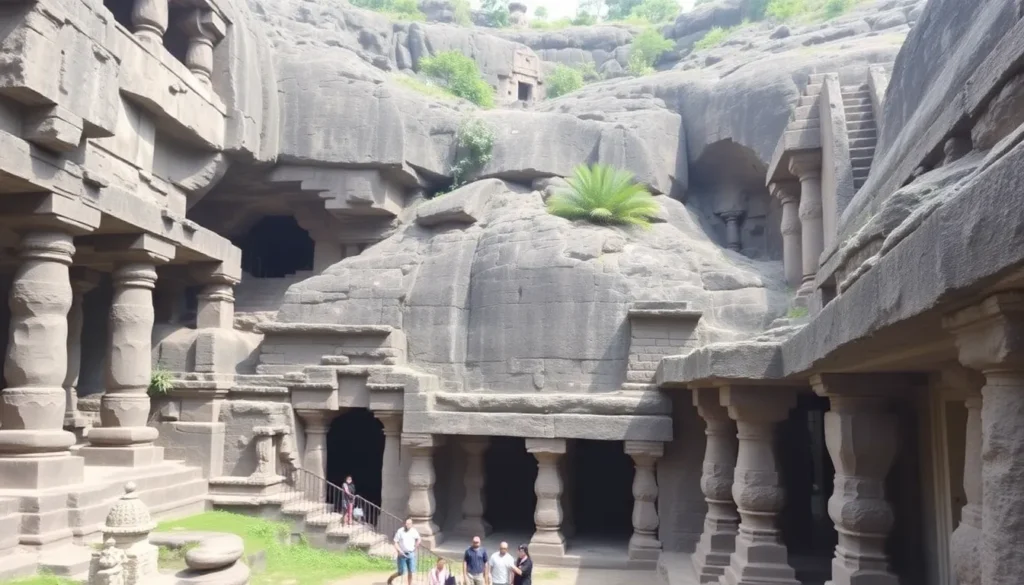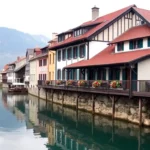Our experience visiting the Ellora Caves in India

Leaving Mumbai behind, we set off on an adventure to Aurangabad, the closest city to the breathtaking Ellora Caves. But what exactly are these caves, you might ask?
Ellora Caves are a remarkable collection of rock-cut caves, recognized as a UNESCO World Heritage Site. Over a span of five centuries, Buddhist, Hindu, and Jain monks and devotees meticulously carved these caves into stone, creating stunning sculptures, temples, chapels, and altars. The overall beauty of this site is astonishing, and we were quite surprised by its lesser-known status!
A deep dive into the significance of Ellora Caves
Ellora comprises 34 caves: 12 are Buddhist, 17 Hindu, and 5 Jain. Our exploration began with the Buddhist caves, some of which were less remarkable, but others left us in awe. The craftsmanship and vision behind these stone creations are truly extraordinary. How could humans achieve such intricate beauty from rock?
Among the Buddhist caves, the cave number 10 stood out to us with its magnificent seated Buddha and a ceiling adorned with carved arches. It felt as if we had stepped into a realm of serenity and artistic brilliance.
Experiencing the spiritual vibe of Hindu caves
As we transitioned to the Hindu caves, our stomachs reminded us it was time to refuel. We savored a delightful malai kofta and jeera aloo, which was delicious! With our bellies satisfied, we continued our journey to the Kailasa Temple, possibly the most breathtaking of all. Its architectural details and sculptures left us completely mesmerized.
We continued exploring the other Hindu caves, some of which featured multiple levels. Climbing stairs was a workout, but we were determined to enjoy every moment. The intricate carvings and the sheer scale of these structures were beyond anything we had ever experienced.
Unveiling the Jain caves
Next, we headed to the Jain caves. Perhaps it was fatigue from all the walking and climbing (it was quite hot too!), but these caves didn’t captivate us as much as the others. The only one that truly impressed us was cave number 30, known as the “Little Kailasa.” We took countless photos while witnessing fellow tourists posing in the most unexpected places, adding a touch of humor to our journey.
Exploring beyond Ellora: Additional attractions in Aurangabad
For anyone planning a trip to Aurangabad, there are several other attractions worth visiting. The Ajanta Caves (which we had to skip due to time constraints), the Daulatabad Fort (which we admired from the bus on our way to Ellora), and the Bibi Ka Maqbara, commonly known as the Baby Taj Mahal, are all notable sites. Arshall, the owner of our hotel, kindly took us to Bibi Ka Maqbara, and we were amazed by its resemblance to the Taj Mahal. If someone had told us it was the real deal, we might have believed them. However, after visiting the original, we knew this one was smaller and less ornate, yet still enchanting!
During our stay in Aurangabad, we celebrated New Year's Eve with a delectable meal of tandoori chicken, rice, naan, and fried fish in a Chinese restaurant beneath our hotel. We spent about 400 INR, roughly €2 per person, making it one of the most affordable New Year’s celebrations we’ve ever had! With our adventure in Aurangabad behind us, we now look forward to heading to our next destination: the beach!
Practical information for visiting Aurangabad and Ellora
Getting to Aurangabad
We traveled from the Dadar train station in Mumbai. The second sitting ticket cost us 150 INR each, and the journey took about six hours.
Where to stay
We spent our nights at SPARKLING PEARL, which offered great hospitality.
Visiting the Ellora Caves
How to get there
Buses depart frequently from the MSRTC bus station (commonly known as the Central Bus Stand). A ticket costs around 30 INR, and the ride takes about 45 minutes, although road conditions might vary. Shared tuk-tuks to the MSRTC are available for 20 INR per person, which is more economical than hiring a private tuk-tuk.
Return trip options
For our return, we opted for a shared jeep (35 INR) to take us back to the MSRTC. It took a bit longer due to traffic, but it wasn't an issue.
Costs and entry fees
The entry fee to the Ellora Caves is 250 INR, with no discounts for students, and there are no additional charges for cameras or video equipment.
Touring the caves
We explored the caves on foot and thoroughly enjoyed the experience. We started from cave 1 and made our way to 34, taking breaks along the way. The entire tour took us about four hours, but some visitors complete it much faster. Please note that the path to cave 29 is blocked, requiring a detour back to cave 24 and a short walk along the road (around 5 minutes).
While it’s possible to take a tuk-tuk to the Jain caves, there is a direct path of less than 1 km leading there. If you return on foot, you can easily find your way back to the entrance in just 15 minutes or less, saving you some money!
For a visual tour of the incredible Ellora Caves, check out this informative video:




Deja una respuesta